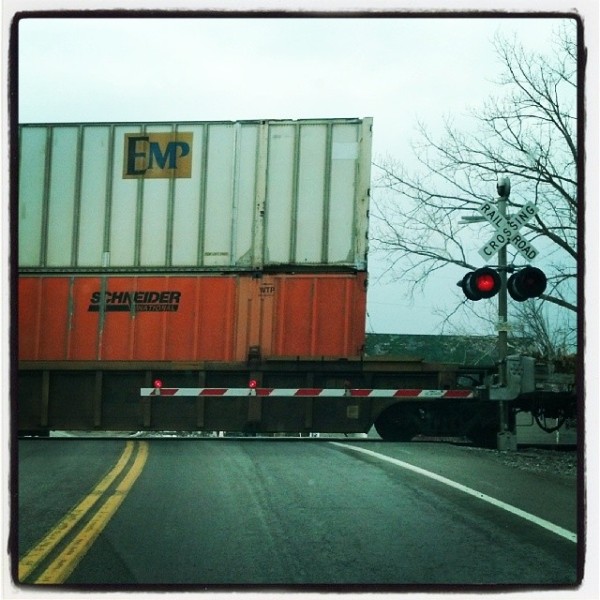Kalida, Ohio is the sort of place you notice because the train crossing makes you wait five minutes.

And then you wait again, 10 minutes down the road.
That section of northwest Ohio — between the Indiana state line and I-75 through Lima, Findlay, and Bowling Green — doesn’t attract crowds. Dull green signs mark flat farmland with three houses and a crossroads as a village. A few towns claim county seats, such as Defiance (30 minutes north of Kalida) and Bryan (30 minutes north of Defiance). Manufacturing drives the economy of Defiance, and a small liberal arts college makes it a prototype of the Midwestern town. If you’ve heard of Defiance, it’s probably from the band of the same name (but formed in Columbus, those liars). Bryan postures as “perhaps the finest small town in the State of Ohio,” which sounds like some haughty Eagletonian talk. However, the Spangler Candy Company produces Dum Dum suckers there, so maybe that claim is justified.
Bryan has a beautiful county courthouse, as well as many of the surrounding towns in that corner of the state. Traveling through the area, it’s well worth a stop.
Why would you travel through the area?
Its history and architecture. If you’re German and Catholic, it’s even better. Putnam and Mercer counties were founded by German Catholics during the early 19th century. Due to low population and the strength of agriculture in the area, the influence remained dominant. The two counties are the most Catholic in the state, 74 and 72 percent respectively, while only 24 percent of Ohioans identify as Catholic, according to a 2008 Pew Forum poll. Delphos, Ohio provides an example of the area’s Catholic colonization:
The colony at Delphos was begun in 1836 when a German priest, Fr. John Bredeick sent his brother Frederick to America to establish a German Catholic community. Frederick Bredeick purchased 92 acres for the future Delphos in an area that was already being settled by planned German Catholic communities. The first group of 42 people left Germany in August of 1842 and began clearing land for the future town the next spring. Fr. Bredeick, who was himself unable to leave Germany until 1844, had sent a second group of colonists in 1843, and he himself finally arrived the next year with a third group. Although from an early date non-Catholics have lived in Delphos, even today the Catholic high school, St. John’s, is larger than the public high school.
The area remains an enclave, much like northeast Ohio’s Amish communities. I noticed more signs about abortion, religious freedom, and the Holy Father than I did road signs.
You don’t pass any welcome signs, though; the church towers looming in the distance would pre-empt them. St. Michael’s in Kalida breaks the horizon six or seven miles before you reach the town. Designed in a Gothic or Romanesque style, the churches reside near schools, farms, or convenience stores.

Mercer and Auglaize counties have roughly 25 Catholic church buildings scattered about; including Putnam, Van Wert, and Allen counties, it’s probably closer to 50.

The reluctance of anything, natural or man-made, to bump the horizon makes the churches striking. Spires and silos from the German Catholic community bookends the state with another religious community on the other side, the Amish with their buggies and barns. As Peter Williams of Miami University (OH) describes it,
In a time of increasing cultural heterogeneity around the country, enclaves like this are more and more unusual … it is an island of exception to broader American trends.
To grasp the area’s history, explore the Putnam County Historical Museum in Kalida (or Montpelier, Wapakoneta, Celina…). Before you leave, visit Hoyt’s Tavern and order the pork tenderloin (delicious and as large as my face). The lack of traffic in the area lets a maverick driver treat speed limits as guidelines rather than rules.
Sweeping and cosmopolitan it is not, but the humble and unique in rural America remain intriguing.
